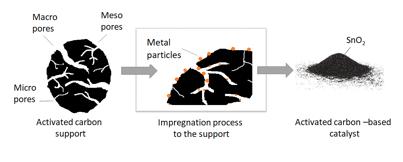
4 minute read
1.2.2 RESULTS
Spruce (saw dust) hydrolysates have been provided by Sekab AB. For these hydrolysates, saw dust has been used in a process to generate hydrolysates containing sugars (figure 3). Various modes of fermentation and process parameters, including addition of detoxifying agents, have been investigated. The resulting yields of sugars and lactic acid have been analyzed by RISE Processum and Centria. Successful 50L pilot scale lactic acid fermentations have been performed using saw dust as raw material.
Advertisement
Figure 3. Saw dust (left) has been converted to hydrolysate (middle) through pretreatment and enzymatic hydrolysis and has subsequently been used to produce lactic acid (right)
Enzymatic hydrolysis
Amounts of biomass and enzyme used in the hydrolysis reactions have been evaluated. The results indicate that the conversion of the cellulose present in the biomass to fermentable glucose is increasingly efficient with higher loading of both biomass and enzyme (figure 4). The process is most productive within the first 24 hours of the reaction.
Lactic acid fermentations
The lactic acid fermentation experiments described here are outtakes of the most representative activities performed during the project. A full description of all experiments performed is beyond the scope of the report. The initial experiments were performed using a bacterial strain that produces a mixture of the two isoforms of lactic acid, D-lactic acid and L-lactic acid. Analyses of the PLA resulting from the fermentations revealed that it contained mesoform PLA as well as monomers of lactic acid. Since the properties of the resulting PLA from such a mixture is inferior to a more optically pure PLA, that is, containing either D- or L-lactic acid, we sought to isolate a bacterial strain that could produce either of the lactic acid isoforms. Isolation of several lactic acid producing strains was performed at the industrial site of RISE Processum AB and one of the strains, producing mostly L-lactic acid, were used in subsequent fermentation experiments. Lactic acid fermentations have been up-scaled from laboratory scale to 50L pilot scale (figure 5).
Figure 4. Effects of biomass and enzyme loading on hydrolysis of fibre sludge to fermentable sugar (left). Comparison of sugar amounts in different hydrolysates (right). PM = pulp mill, FS = fibre sludge, SD = saw dust.
The initial trials were performed with fibre sludge from pulp mills participating in the project. The resulting fibre sludge hydrolysates were used in lactic acid fermentation trials where the raw materials from the two pulp mills performed equally well (figure 4). However, fibre sludge from pulp mill 1 yielded more fermentable sugar and can thus be used for production of higher amounts of lactic acid. In comparison to fibre sludge hydrolysate, lactic acid production in saw dust hydrolysate is slower and requires detoxification for efficient fermentation due to the presence of inhibitors arising in the pretreatment of saw dust (figure 6).
Figure 5. Lactic acid fermentation has been performed in scales from shake flasks (left) to laboratory scale bioreactors (middle) and 50L pilot scale (right)
Figure 6. Lactic acid fermentation in fibre sludge (FS) hydrolysates and saw dust (SD) hydrolysates. PM = pulp mill
Since lactic acid bacteria need nutrients containing nitrogen, in addition to the sugar carbon source, for lactic acid production, extensive optimization of fermentation conditions has been performed resulting in a more economically relevant fermentation process due to a significant reduction of additives needed for efficient lactic acid production (figure 7). In addition, since large volumes of pH adjustment agents such as ammonium hydroxide are needed for an efficient fermentation, optimizations of required pH as well as pH adjusting agents have been performed continuously (figure 8, 10). As a result, the required pH level has been reduced, leading to a more economical process. Below are examples of optimization trials performed during the project.
Different modes of fermentation have been evaluated within the project. The results indicate that fed-batch mode yields the most productive mode of lactic acid production in fibre sludge hydrolysate and even more so in saw dust hydrolysates where productivity in batch-mode is significantly lower (figure 9). Continuous fermentation mode has also been investigated and fed-batch mode was more productive than continuous mode as well.
Figure 7. Effects of nutrient additives on lactic acid fermentation in fibre sludge (left) and saw dust (right) hydrolysate
Figure 8. Lactic acid production at different pH in fibre sludge (left) and saw dust (right) hydrolysates
Figure 9. Fed-batch versus batch fermentation of lactic acid in fibre sludge (left) and saw dust (right) hydrolysates.
In the later stages of the project, a more pure and concentrated (with separated sugars and less inhibitors) saw dust hydrolysate from Sekab AB was used to investigate whether an improved lactic acid fermentation could be achieved using saw dust as raw material. Indeed, lactic acid was efficiently produced in this hydrolysate and no detoxifying agent was needed (figure 10).
Successful 50L scale fermentations have been performed during the project to produce enough lactic acid for subsequent polymerization trials (figure 11). As an effect of the promising results using saw dust, an industrial scale lactic acid fermentation using saw dust as raw material is in the pipeline for the near future.
Figure 10. Effects of pH adjusting agents (left) in fibre sludge hydrolysate and detoxification (right) in pure saw dust hydrolysate
Figure 11. Lactic acid fermentation in 50 liter scale in fibre sludge hydrolysate (left, batch) and saw dust hydrolysate (right, fed-batch) GREEN BIORAFF SOLUTIONS








